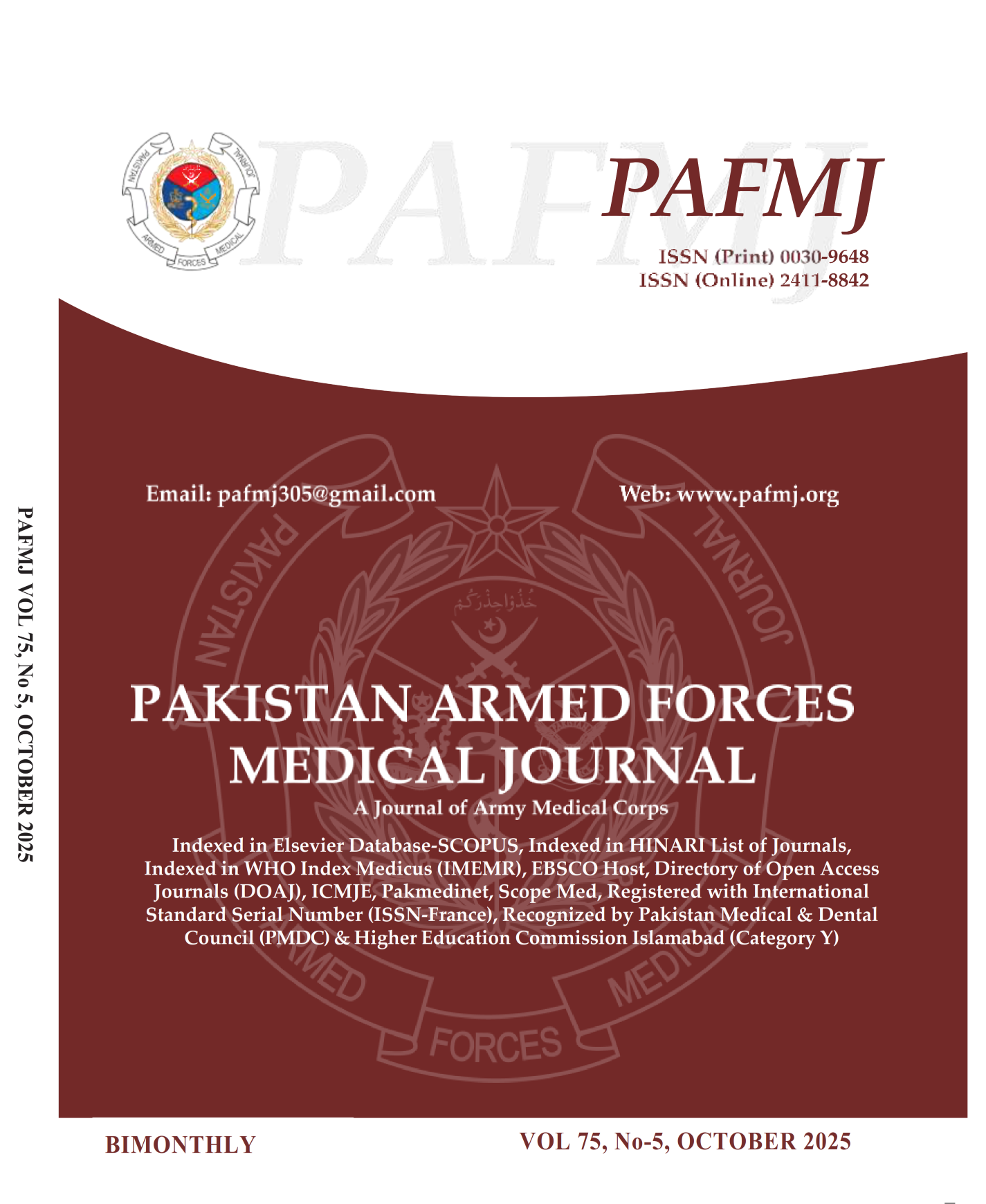Comparative Efficacy of 25% Trichloroacetic Acid Peel Versus 30% Salicylic Acid Peel in Mild to Moderate Acne Vulgaris
DOI:
https://doi.org/10.51253/pafmj.v75i5.9910Keywords:
Acne Vulgaris, Michaelson Acne Score, Salicylic Acid, Trichloroacetic AcidAbstract
Objective: To compare the efficacy of 25% trichloroacetic acid peel (TCA) versus 30% salicylic acid peel (SA) in mild to moderate acne vulgaris.
Study Design: Randomized Control Trial (ClinicalTrials.gov: NCT05712837).
Place and Duration of Study: Department of Dermatology, Combined Military Hospital, Abbottabad Pakistan, from Jun to Nov 2022.
Methodology: Sixty patients with mild and moderate facial acne vulgaris (i.e, comedones, papules and pustules) diagnosed by consultant dermatologist on clinical presentation were included in this study. After randomization, patients were divided into two groups. Group-A was managed with 25% Trichloroacetic Acid (TCA) peel, while Group-B was managed with 30% Salicylic acid (SA) peel. Clinical evaluation was done and recorded initially at the start of therapy and then at every fourth week for twelve weeks. Efficacy was compared in both groups at the end of twelve weeks.
Results: 30% SA peel was more efficacious in achieving good MAS count (64.57±1.176) at the end of 12-weeks as compared to 25% TCA peel (54.30±3.52) (p-value <0.001).
Conclusion: This randomized controlled trial showed that 30% SA peel was more efficacious in treating mild-to-moderate acne vulgaris of the face compared to 25% TCA peel.
Downloads
References
1. Dayal S, Singh S, Sahu P. Efficacy and safety of 25% trichloroacetic acid peel versus 30% salicylic acid peel in mild-to-moderate acne vulgaris: a comparative study. Dermatol Pract Concept 2021; 11(3): e2021063.
https://doi.org/10.5826/dpc.1103a63
2. Del Duca E, Manfredini M, Petrini N. Daylight Photodynamic Therapy with 5-aminolevulinic acid 5% gel for the treatment of mild-to-moderate inflammatory acne. G Ital Dermatol Venereol 2019; 156(1): 46-50.
https://doi.org/10.23736/s2784-8671.19.06392-2
3. Sidiq M, Ganga vellaisamy S, Gopalan K, Kandasamy M. A comparative study of efficacy & tolerability of 30% salicylic acid versus 20% salicylic acid + 10% mandelic acid peel for acne vulgaris. J Pak Assoc Dermatol 2019; 29(2): 188-195.
4. Fan H, Tuo H, Xie Y, Ju M, Sun Y, Yang Y, et al. Comparison of blue laser and red light-emitting diode-mediated aminolevulinic acid-based photodynamic therapy for moderate and severe acne vulgaris: A prospective, split-face, nonrandomized controlled study. Photodiagnosis Photodyn Ther 2024; 49: 104325.
https://doi.org/10.1016/j.pdpdt.2024.104325
5. Karia U, Mehul P, Bela P. A study of efficacy and safety of newer chemical peels for acne vulgaris grade 1 to 3. IP Indian J Clin Exp Dermatol 2022; 8(3): 180–185.
https://doi.org/10.18231/j.ijced.2022.037
6. De Vries FMC, Meulendijks AM, Driessen RJB, van Dooren AA, Tjin EPM, van de Kerkhof PCM. The efficacy and safety of non-pharmacological therapies for the treatment of acne vulgaris: A systematic review and best-evidence synthesis. J Eur Acad Dermatol Venereol 2018; 32(7): 1195-1203.
https://doi.org/10.1111/jdv.14881
7. Cannarozzo G, Silvestri M, Tamburi F. A new 675-nm laser device in the treatment of acne scars: an observational study. Lasers Med Sci 2021; 36(1): 227–231.
https://doi.org/10.1007/s10103-020-03063-6
8. Umesh K, Mehul P, Bela P. A study of efficacy and safety of newer chemical peels for acne vulgaris grade 1 to grade 3. Indian J Clin Experimental Dermatol 2022; 8(3): 180–185.
https://doi.org/10.18231/j.ijced.2022.037
9. Abdel Meguid AM, Elaziz Ahmed Attallah DA, Omar H. Trichloroacetic acid versus salicylic acid in the treatment of acne vulgaris in Dark-skinned patients. Dermatol Surg 2015; 41(12): 1398–1404. https://doi.org/10.1097/dss.0000000000000522
10. Abdel Hay R, Hegazy R, Abdel Hady M, Saleh N. Clinical and dermoscopic evaluation of combined (salicylic acid 20% and azelaic acid 20%) versus trichloroacetic acid 25% chemical peel in acne: an RCT. J Dermatol Treat 2019; 30(6): 572–577.
https://doi.org/10.1080/09546634.2018.1484876
11. Dayal S, Amrani A, Sahu P, Jain VK. Jessner’s solution vs. 30% salicylic acid peels: a comparative study of the efficacy and safety in mild-to-moderate acne vulgaris. J Cosmet Dermatol 2017; 16(1): 43–51. https://doi.org/10.1111/jocd.12266
12. Dayal S, Kalra KD, Sahu P. Comparative study of efficacy and safety of 45% mandelic acid versus 30% salicylic acid peels in mild-to-moderate acne vulgaris. J Cosmet Dermatol 2020; 19(2): 393–399. https://doi.org/10.1111/jocd.13168
13. Aneesh B, Bifi J, Thyvalappil A, Rajiv S, Ajayakumar S, pretty mathew. Effect of 30% salicylic acid peels in mild to moderate acne vulgaris: a hospital-based nonrandomised clinical study. J Pak Assoc Dermatol 2018; 28(2): 146-151.
14. Michaelsson G, Juhlin L, Vahlquist A. Oral zinc sulphate therapy for acne vulgaris. Acta Derm Venereol 1977; 57(4): 372.
15. Khunger N, Chanana C. A perspective on what’s new in chemical peels. Cosmo Derma 2022; 2: 14.
https://doi.org/10.25259/CSDM_5_2022
16. Khunger N, Vedamuthy M, Arsiwala S, Vedamurthy A. Tretinoin peels. In: Khunger N, editor. Step by Step Chemical Peels. New Delhi: Jaypee Brothers Medical Publishers (P) Ltd; 2009: 159–178.
17. Levesque A, Hamzavi I, Seite S, Rougier A, Bissonnette R. Randomized trial comparing a chemical peel containing a lipophilic hydroxy acid derivative of salicylic acid with a salicylic acid peel in subjects with comedonal acne. J Cosmet Dermatol 2011; 10(3): 174–178.
https://doi.org/10.1111/j.1473-2165.2011.00566.x
18. Khunger N. Trichloroacetic acid peels. In: Khunger N, editor. Step by Step Chemical Peels. 2nd ed. New Delhi: Jaypee Brothers Medical Publishers Ltd; 2014: 79–110.
19. Bava A, Joy B, Anoop T, Sridharan Rajiv, Sreenivasan A, Mathew P. Effect of 30% salicylic acid peels in mild to moderate acne vulgaris: a hospital-based non-randomised clinical study. J Pak Assoc Dermatol 2018; 28(2): 146-151.
20. Khunger N, Chanana C. A perspective on what’s new in chemical peels. Cosmo Derma 2022; 2: 14.
https://doi.org/10.25259/CSDM_5_2022
21. Zaenglein AL, Pathy AL, Schlosser BJ. Guidelines of care for the management of acne vulgaris. J Am Acad Dermatol 2016; 74(5): 945–973.
https://doi.org/10.1016/j.jaad.2015.12.037
22. Bava A, Joy B, Anoop T, Sridharan R, Sreenivasan A, Mathew P et al. Effect of 30% salicylic acid peels in mild to moderate acne vulgaris: a hospital-based nonrandomised clinical study. J Pak Assoc Dermatol 2018; 28(2): 146-151.
Downloads
Published
Issue
Section
License
Copyright (c) 2025 Kiran Gul, Bushra Muzaffar, Muhammad Adeel Siddiqui, Majid Hussain, Sara Ilyas, Huma Farid

This work is licensed under a Creative Commons Attribution-NonCommercial 4.0 International License.















